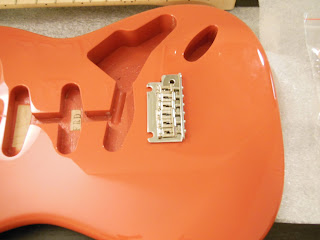I finally got my newest shipments of goodies today.
Before I looked at the guitar stuff, I wanted to make some dinner.
The first package contained a bottle of hot sauce that I've been wanting to try for a while: Dave's Gourmet Scorpion Pepper hot sauce.
I'm a big fan of their Ghost Pepper sauce, which is really good but extremely spicy. I believe scorpion peppers are the hottest in the world now, hotter than the ghost pepper (which was the hottest a couple years ago). A couple of my pepperhead friends and I enjoy spicy foods, and I ordered a couple bottles so we each could have one.
Before reviewing the remaining items from the packages, I cooked up a couple of hot dogs for a quick dinner:
I didn't hold back on the Scorpion Pepper sauce (the orange bits on top of the ketchup). It really has an intense sting! It's got a similar consistency to Sriracha hot sauce (the chunkier chili garlic one) and has a slightly sweet, fresh pepper flavor that delivers extreme heat very quickly (where the Ghost Pepper sauce is smooth like ketchup and delivers an intense slow burn after its initial fruity, more processed flavor). Highly recommended if you like extreme hot sauces, but definitely not for the faint of heart (or weak of bowels).
Onto the guitar stuff then...
I got The Fender Stratocaster Handbook by Paul Balmer. It's got a bunch of information on maintenance and setup, and I figure having more material to look at while I continue the build will make me avoid any problems. I'm also trying to get some ideas and detailed specs on vintage Strats; once I finish this build and if it turns out well, I might think about a future build where I build something close to the vintage stuff (my current build is going to be a modern workhorse type of design).
Here's the part that has kept me waiting for over 2 weeks...the tremolo bridge!
It's only the core part of the complete bridge assembly. Fender has been constantly changing the specs on its guitars ever since the first Strats were released. For this build, I wanted an American Standard type tremolo with the 2-pivot bridge posts, but Fender switched the design a bit a couple of years ago. I wanted the newest designed assembly but couldn't find any place that was selling the complete assembly. Most places only offered the upgrade unit (only the changed parts) intended for replacing already existing Strat tremolos. My solution was to order the upgrade unit and then source all the other parts myself. I priced everything out and realized I'd save a bunch of money this way rather than buy the old assembly plus the new upgrade or buying the new assembly complete, directly from Fender (waaaaay overpriced). Another difference is the fact that the American Standard spaces its outer strings 2 1/16 inches apart, compared to the vintage spacing of 2 7/32 inches. I'm more familiar with the Superstrat (rock/metal Stratocaster-inspired guitars that have a lot more modern specs focused on playability) and therefore, I prefer the narrower spacing, which is another reason why I chose to go with the American Standard tremolo.
When I ordered the upgrade unit, I wasn't sure which parts I'd actually receive and which parts would be missing. Now that I've gotten the unit, I can order all the rest of the parts before. When I've gotten all the rest of the tremolo parts, I'll have enough to be able to drill the posts to mount the tremolo, and also to mount the neck to the body. That's probably the most critical part of the build because the alignment of the neck with body/strings/bridge, alignment of the bridge mounting locations need to be done together to make sure everything fits and will intonate correctly. If I screw up the tremolo positioning, it'll affect the neck alignment, whether or not I can ever get the guitar intonation right, and pretty much whether the guitar will work. I can always plug and redrill, but I'd much rather get it right the first time, especially since the body is so nice. Once I have neck + body + bridge, I'll have enough to be able to put strings on it and begin the setup process.
Shiny...
...Metal...
...Parts...
...♥
The Fender American Standard bridge is fundamentally different in design to the vintage design because of how the plate mounts to the guitar. The American Standard bridge has 2 pivot holes rather than the traditional 6 screw holes (1 for each string) to reduce friction. The guitar trem is like a lever that can be pressed down to move the strings and change the pitch of the notes. The problem with the older vintage design is that the 6 screws can cause a lot more friction as each screw might bind on the tremolo action. With too much friction, the strings have a hard time getting back to the correct tuning. The 2 pivot design is supposed to reduce friction and allow the strings to get back into pitch more accurately.
Bent steel saddles.
The bridge block. This thing is surprisingly heavy. It's got a bevel so that when using the tremolo, there's a bit more room to continue to push the tremolo arm down without the block hitting the inside cavity of the body.
A reminder of what the body looks like:
Just putting the tremolo unit in to show where it'll be once I install it.















No comments:
Post a Comment